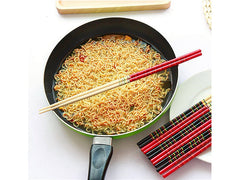About Japanese chopsticks
In short
- Hashi tradition: Japanese chopsticks (箸) were once sacred tools in rituals, symbolizing communion between humans and gods.
- Evolution: From bent bamboo sticks in the Nara period, chopsticks replaced spoons as rice-eating culture spread.
- Etiquette matters: Actions like stabbing food (sashi-bashi) or passing food between chopsticks (hiroi-bashi) are considered disrespectful.
- Modern use: Chopsticks now extend beyond dining — from elegant gift sets to practical cooking tools — blending utility with cultural artistry.
Our Japanese online store offers a wide and diverse selection of authentic, made-in-Japan chopsticks, perfect for enhancing your dining experience with a touch of traditional elegance.
Common writing mistakes like "chopstix", "chop sticks", and "chopstick" can be avoided by simply referring to them as "Hashi". Embracing this term not only respects the cultural significance but also ensures clarity and accuracy.
Japanese chopsticks, known as Hashi (箸), hold a sacred place in Japanese culture. Historically, they were used as holy tools in religious services where food was offered to deities. It was believed that chopsticks symbolized the communion between gods and humans during meals.
Hashi are versatile tools that can be used in various ways, such as holding small items, cutting, and splitting food. Their usage, however, depends on one's skill level and familiarity with chopstick etiquette. As chopsticks gained popularity, their original uses evolved. For instance, they became a stylish tool for fixing hair, transforming eating chopsticks into hair chopsticks, a trend that highlights their beauty and versatility.

For special occasions, explore our curated selection of chopsticks gift sets. Additionally, for those who prefer to carry their chopsticks everywhere, we offer a special selection of Japanese chopsticks with cases, ensuring convenience and style on the go.

Our cooking chopsticks are designed for ease of use in the kitchen, making them an essential tool for any culinary enthusiast.
Discover our selection of high-quality wood and bamboo chopsticks, along with stylish chopstick rests inspired by Japanese culture and arts. These pieces bring a touch of Japan to your table, making every meal a cultural experience. For those who prefer not to use chopsticks, we also offer a beautiful collection of ramen spoons (renge) and more.
The History of Chopsticks in Japan
From Spoons to Chopsticks
During the Yayoi period (300 BC to 300 AD), when rice cultivation began, people initially consumed porridge made from unpolished rice and cereals. Archaeological findings suggest that wooden spoons were used to eat from bowls during this era.
As steamed rice became more prevalent, the use of hands for eating was documented in the Wajinden, a Chinese text from the late third century. The introduction of chopsticks occurred during the Nara period (710 to 794 AD), initially made from bent bamboo sticks. Over time, the use of two separate sticks became the norm, and the spoon fell out of favor as people adopted the practice of lifting bowls to drink directly from them.
Mastering Chopstick Etiquette in Japan
The Art of Using Chopsticks
In Japan, mastering the art of holding and using chopsticks is essential for enjoying meals properly. Beyond technical skills, there is a specific etiquette for each action, from picking up chopsticks to placing them down.
Certain actions are considered impolite or inappropriate. For example, "Koji-bashi" refers to the act of picking only your favorite food from a shared dish. Here is a guide to chopstick etiquette:
Avoid the following:
- Sashi-bashi: Stabbing food with chopsticks.
- Odori-bashi: Waving chopsticks in the air while talking or pointing them at someone.
- Mochi-bashi: Lifting a dish with the hand holding the chopsticks.
- Mayoi-bashi: Moving chopsticks from dish to dish while deciding what to eat.
- Neburi-bashi: Sucking the ends of chopsticks or removing food with your mouth.
- Arai-bashi: Washing the ends of chopsticks in soup or other liquids.
- Yose-bashi: Moving dishes closer using chopsticks.
- Watashi-bashi: Placing chopsticks across a dish during a meal.
- Tate-bashi: Standing chopsticks upright in a rice bowl.
- Hiroi-bashi: Passing food from one pair of chopsticks to another.
"Wari-bashi," or disposable chopsticks, are commonly used in restaurants and when hosting guests. This tradition stems from the historical practice of individuals having their own personal chopsticks, which they preferred not to share with others.
SHARE:

